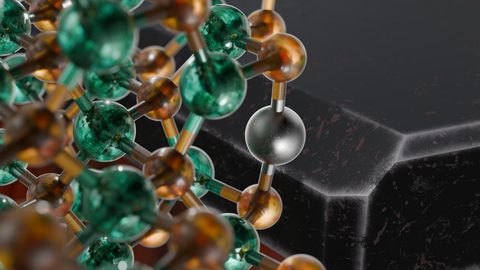Feb 25, 2025
From defect to high-tech material

A section of the atomic structure of a cadmium selenide nanoparticle (left) with an incorporated foreign mercury atom; and an artistic representation of a highly magnified nanoplatelet with mercury defects at its active corners (right).
Cadmium selenide nanoplatelets provide a promising foundation for the development of innovative electronic materials. Since the turn of the millennium, researchers around the world have taken a particular interest in these tiny platelets, which are only a few atoms thick, as they offer extraordinary optical and other properties. A team from the Helmholtz-Zentrum Dresden-Rossendorf (HZDR), TU Dresden, and the Leibniz Institute for Solid State and Materials Research Dresden (IFW) has taken an important step towards the systematic production of such nanoplatelets. The researchers were able to gain fundamental insights into the interaction between structure and function, as they report in the journal Small.
Cadmium-based nanostructures lend themselves to the development of two-dimensional materials that enter into specific interactions with near-infrared light (NIR) by either absorbing, reflecting, or emitting light, or exhibiting other optical properties. This spectral range is of interest for numerous technologies. In medical diagnostics, for example, such materials offer deeper insights into tissue, since NIR light is scattered less than visible light. In communications technology, NIR materials are used in highly efficient fiber-optic systems. In solar energy, they could increase the efficiency of photovoltaic cells.
“The ability to specifically modify the material to present the desired optical and electronic properties is crucial for all these applications,” says Dr. Rico Friedrich from the Institute of Ion Beam Physics and Materials Research at HZDR and Chair of Theoretical Chemistry at TU Dresden. “In the past, this was a challenge because nanochemical synthesis used to be more about mixing materials by trial and error,” adds Prof. Alexander Eychmüller, Chair of Physical Chemistry at TU Dresden. The two scientists jointly led the collaborative research project.
An innovative approach: Cation exchange to produce well-defined nanoparticles
The particular challenge here is to specifically control the number of atomic layers and their composition in the nanostructures (and thus their thickness) without altering their width and length. The synthesis of such complex nanoparticles is a key challenge in materials research. This is where cation exchange comes in. In this method, certain cations – positively charged ions – in a nanoparticle are systematically replaced with others. “The process gives us precise control over the composition and structure, allowing us to produce particles with properties that we could not attain using conventional synthesis methods. However, little is known about the exact workings and starting point of this reaction,” says Eychmüller.
In the current project, the team focused on nanoplatelets, whose active corners play a crucial role. These corners are particularly chemically reactive, which makes it possible to bind the platelets into organized structures. To better understand these effects, the researchers combined sophisticated synthetic methods, atomic-resolution (electron) microscopy, and extensive computer simulations.
Active corners and defects in nanoparticles are not only interesting because of their chemical reactivity, but also their optical and electronic properties. These places often have a high concentration of charge carriers, which can affect their transport and the absorption of light. “Combined with an ability to exchange single atoms or ions, we could also use such defects in single-atom catalysis, harnessing the high reactivity and selectivity of individual atoms to increase the efficiency of chemical processes,” explains Friedrich. Precise control of such defects is also crucial for the NIR activity of nanomaterials. They affect how near-infrared light is absorbed, emitted, or scattered, offering ways to systematically optimize optical properties.
Linking nanostructures: A step towards self-organization
Another outcome of this research is the possibility to systematically link nanoplatelets by their active corners, combining the particles into ordered or even self-organized structures. Future applications could use this organization to produce complex materials with integrated functions, such as NIR-active sensors or new types of electronic components. In practice, such materials could increase the efficiency of sensors and solar cells or facilitate new methods of data transmission. At the same time, the research also generates fundamental insights for other areas of nanoscience, such as catalysis or quantum materials.
The team’s findings were only possible thanks to a combination of state-of-the-art synthetic, experimental, and theoretical methods. The researchers were not only able to precisely control the structure of the nanoparticles, but also investigate the role of the active corners in detail. Experiments on atomic defect distribution and compositional analysis were combined with theoretical modeling to gain a comprehensive understanding of the material properties.
Publication: V. Shamraienko, R. Friedrich, S. Subakti, A. Lubk, A. V. Krasheninnikov, A. Eychmüller, Weak Spots in Semiconductor Nanoplatelets: From Isolated Defects Toward Directed Nanoscale Assemblies, in Small, 2024 (DOI: 10.1002/smll.202411112).
More information:
Dr. Rico Friedrich
Institute of Ion Beam Physics and Materials Research at HZDR
Chair of Theoretical Chemistry
TU Dresden
Phone: +49 351 260 3718
E-Mail:
Prof. Alexander Eychmüller
Chair of Physical Chemistry
TU Dresden
Phone: +49 351 463 39843
E-Mail:
